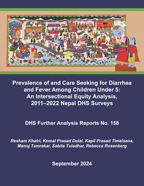There is no printed copy available to order.
Abstract:
Nepal has made remarkable progress in preventing major childhood illnesses, such as diarrhea, acute respiratory infections, measles, malaria, and malnutrition, by implementing community-based child health programs. This study investigated trends in and determinants of key childhood illnesses and care-seeking practices based on socioeconomic and demographic factors in Nepal.
The trend analyses were conducted using data from the 2011 Nepal Demographic and Health Survey (NDHS) (n=5,140), the 2016 NDHS (n=4,887), and the 2022 NDHS (n=5,040) among children under 5 who had experienced diarrhea or fever in the 2 weeks prior to the survey. Determinants of care seeking were identified using data from the 2022 NDHS among children with diarrhea (n=524) and fever (n=1,159).
We found increasing trends in childhood diarrhea and fever prevalences, as well as decreasing trends in care-seeking practices for both illnesses. Among those who sought care, the majority sought care from private health facilities (HFs). Diarrhea was significantly less likely among children age 36–59 months, but significantly more likely among children from Bagmati and Karnali provinces and those from Hill and Terai ecoregions, than among respective reference groups. The only significant determinant of care seeking for diarrhea was birth order of children, with care seeking less likely among firstborn children than those born second. Care seeking for diarrhea in private HFs was significantly more likely among children in Lumbini province than among those in Sudurpaschim, and significantly more likely among those born to native Maithili speakers or speakers of other languages than among those born to native Nepali speakers.
Fever was significantly more likely among children age 6 months to 4 years, those born to native Nepali speakers, and those with a second birth order than among respective reference groups. The odds of care seeking for fever were significantly lower among children born to mothers with one or more disadvantages than among children born to mothers with no disadvantages; they were significantly higher among children from Madhesh province than among those from Sudurpaschim. Care seeking for fever in private HFs was significantly more likely among children born to mothers with one or no disadvantages, those in Lumbini and Madhesh provinces, those in urban areas, and those born to native Maithili speakers when compared with respective reference groups.
Multisectoral policies and actions such as interventions for safe drinking water, improved hygiene and sanitation, and better nutrition can be designed and implemented to address the root causes of childhood illnesses. HFs need strengthened capacity to ensure optimal quality of care. Nepal’s Community-Based Integrated Management of Neonatal and Childhood Illnesses Program requires strengthening through system inputs, including provision of essential medicines and supplies, training of health staff, and regular availability of services. Programs that target marginalized populations with multiple disadvantages need to be designed and implemented in coordination with local governments. These programs should recruit health care providers who speak the local language and know the culture, identify local problems, address community health needs, and unlock the potential of health education, information, and communication programs in local languages in Madhesh and Lumbini provinces.
 Prevalence of and Care Seeking for Diarrhea and Fever Among Children Under 5: An Intersectional Equity Analysis, 2011–2022 Nepal DHS Surveys (PDF, 3262K)
Prevalence of and Care Seeking for Diarrhea and Fever Among Children Under 5: An Intersectional Equity Analysis, 2011–2022 Nepal DHS Surveys (PDF, 3262K)
